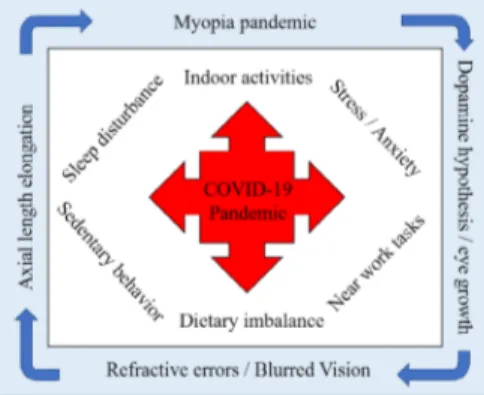Letter to the Editor
Clin Exp Optom 2020Response to Re:
COVID-19, sweat,
tears
… and myopia?
Valentin Navel*† MD
Frédéric Chiambaretta*†MD PhD Frédéric Dutheil‡§MD PhD
*Translational Approach to Epithelial Injury and Repair, CNRS, INSERM, GReD, Université Clermont Auvergne, Clermont-Ferrand, France
†Ophthalmology, CHU Clermont-Ferrand, University
Hospital of Clermont-Ferrand, Clermont-Ferrand, France
‡Physiological and Psychosocial Stress, LaPSCo, CNRS,
Université Clermont Auvergne, Clermont-Ferrand, France
§
Preventive and Occupational Medicine, CHU Clermont-Ferrand, University Hospital of
Clermont-Ferrand, Witty Fit, Clermont-Ferrand, France E-mail: valentin.navel@hotmail.fr
DOI:10.1111/cxo.13124
EDITOR: We thank Jiang et al.1for their
rele-vant comment on the putative relation between myopia and coronavirus disease 2019 (COVID-19).2 As explained by the
authors, global quarantine measures could affect the lifestyle of young people by pro-moting near work activities, physical inactivity, dietary imbalance (that is, snacking and irreg-ular meals) and anxiety (that is, fear of contagion).
Jiang et al.1also noted that myopic patients,
who have a higher risk of ocular complica-tions (for example, refractive errors, retinal tearing with retinal detachment), could strug-gle to attend regular eye examinations.
A greater amount of time indoors during extended periods of confinement could exac-erbate exposure to artificial light in mesopic conditions. However, recent data suggest that time spent outdoors during childhood (that is, exposure to ultraviolet light) could protect against axial elongation of myopic eyes, therefore reducing the incidence of myopia.3
Laboratory studies suggest that the effect of sunlight exposure on axial elongation could be mediated by dopamine secretion within the retina (that is, dopamine theory).4 Thus,
modifying environmental exposure (such as time spent outdoors) seems to be relevant to reducing myopic progression.3
Interestingly, physical activity, duration of sleep, and diet may also influence refractive error, axial length, and the incidence of myo-pia. Regular physical activity (more than three hours per week) is associated with a lower prevalence of myopia (odds ratio [OR] 0.46, 95% CI 0.23–0.90).5 However, it is difficult to
elucidate whether the beneficial role on myo-pic development is related to active behav-iour or increased exposure to ultraviolet light.6 Similarly, a recent study in a Korean
population showed an inverse relationship between sleep duration and myopia, whereby sleeping more than nine hours is protective against myopic progression (OR 0.59, 95% CI 0.38–0.93).7
Given that myopia is a disease of eye development, it seems plausible that abnor-malities in nutritional intake may play a role. Interestingly, trace elements (for example zinc, copper, manganese or selenium) have been detected in abnormal systemic levels in myopic subjects in different ethnicities and geographical origins.8,9 Furthermore,
essential nutrients and vitamins contribute to the structure and activity of many pro-teins and enzymes involved in eye develop-ment and visual function.10 Essential
nutrients are found in vegetables, seafood, numerous nuts, and more generally with a healthy and well-balanced diet.11High food
intake and lack of sleep induces neuropsy-chological remodelling, with low-grade inflammation in the nervous system, stress-induced depression and anxiety.12
Considering the dopamine dysregulation in psychiatric disease13 and the embryological
origins of the retina (that is, neural crest cells), it seems plausible that myopia is linked with a neurological abnormality in dopamine secretion. Myopic subjects, and particularly those with severe myopia, seem to be an at-risk population for depression and anxiety;14
therefore, eye-care practitioners should remain vigilant in respect of the mental health of myopic patients during the SARS-CoV-2 crisis.
Thus, it is salient to consider the complex interplay between myopia and the COVID-19 pandemic, which can alter the pattern of envi-ronmental exposure (that is, indoor activities), near work tasks, sunlight exposure, sleep pat-terns, anxiety levels and food intake (Figure 1).
The COVID-19 pandemic may, in these ways, indirectly facilitate a better under-standing of the myriad of influences upon myopic pathophysiology.
REFERENCES
1. Jiang N, Zhang G, Zhang L et al. Re: COVID-19, sweat, tears… and myopia? Clin Exp Optom 2020. https://doi. org/10.1111/cxo.13120
2. Navel V, Beze S, Dutheil F. COVID-19, sweat, tears… and myopia? Clin Exp Optom 2020; 103: 555. 3. Rose KA, Morgan IG, Ip J et al. Outdoor activity
reduces the prevalence of myopia in children. Oph-thalmology 2008; 115: 1279–1285.
4. Feldkaemper M, Schaeffel F. An updated view on the role of dopamine in myopia. Exp Eye Res 2013; 114: 106–119.
5. O’Donoghue L, Kapetanankis VV, McClelland JF et al. Risk factors for childhood myopia:findings from the NICER study. Invest Ophthalmol Vis Sci 2015; 56: 1524–1530.
6. Read SA, Collins MJ, Vincent SJ. Light exposure and physical activity in myopic and emmetropic children. Optom Vis Sci 2014; 91: 330–341.
7. Jee D, Morgan IG, Kim EC. Inverse relationship between sleep duration and myopia. Acta Ophthalmol 2016; 94: e204–e210.
8. Huo M, Liu H, Cao J. The relationship between serum zinc, copper, selenium and the visions of middle school students. Chin J Sch Health 2006; 4: 318–319.
9. Burke N, Butler JS, Flitcroft I et al. Association of total zinc intake with myopia in U.S. children and adoles-cents. Optom Vis Sci 2019; 96: 647–654.
Figure 1. The complex interplay between
two current pandemics: myopia and
COVID-19
© 2020 Optometry Australia Clinical and Experimental Optometry 2020
1
10. Ugarte M, Osborne NN. Recent advances in the understanding of the role of zinc in ocular tissues. Metallomics 2014; 6: 189–200.
11. Sofi F, Abbate R, Gensini GF et al. Accruing evidence on benefits of adherence to the Mediterranean diet on health: an updated systematic review and meta-analysis. Am J Clin Nutr 2010; 92: 1189–1196.
12. Dutheil S, Ota KT, Wohleb ES et al. High-fat diet induced anxiety and anhedonia: impact on brain homeostasis and inflammation. Neuropsychopharmacology 2016; 41: 1874–1887.
13. Romeo B, Blecha L, Locatelli K et al. Meta-analysis and review of dopamine agonists in acute episodes of
mood disorder: efficacy and safety. J Psychopharmacol 2018; 32: 385–396.
14. Li Q, Yang J, He Y et al. Investigation of the psycho-logical health offirst-year high school students with myopia in Guangzhou. Brain Behav 2020; 10: e01594.
Clinical and Experimental Optometry 2020 © 2020 Optometry Australia
2
